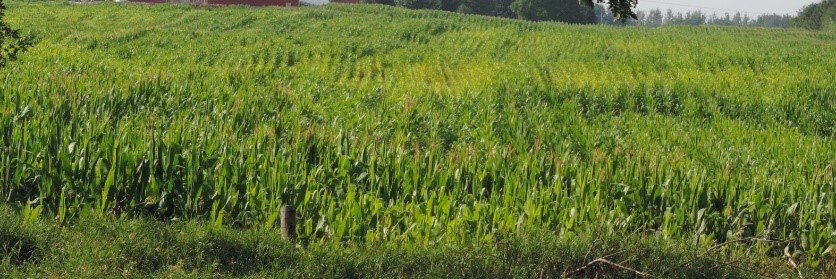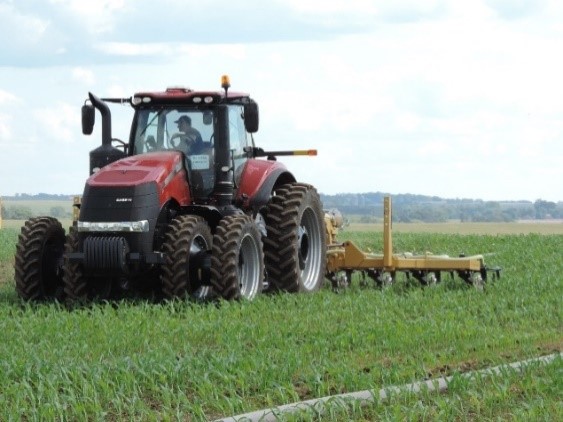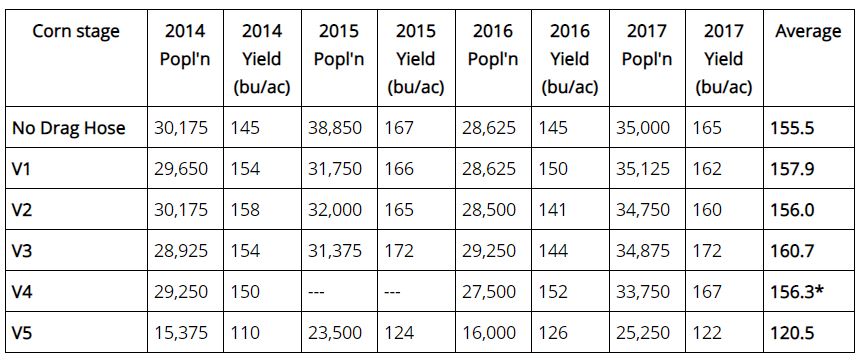Timely planting of corn followed by in-crop manure application up to V4 stage of corn can reduce compaction, increase nutrient use efficiency and increase yield.
$100 per acre extra value from applying manure after corn planting! Did that catch your attention? Nutrient-use efficiency is highest when the nutrients are applied to a growing crop. Field damage from compaction is reduced when field work is performed on relatively dry, well structured soils with good tilth and organic matter levels. Timely planting of corn ahead of manure application can save time and equipment logistics in addition to maximizing heat unit accumulation for the corn crop. (Figure 1 & 2)
Although there is a difference between the composition of various types of liquid manure, injected hog manure and anaerobic digestate are two types that are well suited to provide the nutrients required by a rapidly growing corn crop at side-dress timing.


Corn yields are maximized with a well fertilized crop, however fields where manure has been applied will often outyield fields fertilized with commercial products. The advantage could be the combination of micronutrients, organic matter and microbial stimulation. Liquid manure that is high in ammonium nitrogen (hog manure, anaerobic digestate) is especially well suited for application into a standing corn crop. Table 1 shows that corn with hog manure applied at side-dress timing consistently out-yielded corn with commercial nitrogen applied. The data was collected from a six year on-farm trial in Ohio, conducted by Glen Arnold, Ohio State U. Extension Specialist in Manure Management. The study showed results similar to small-plot research trials.
Table 1. Corn yield with finisher hog manure applied with a drag hose at V3 compared to 28% UAN applied at V3
| Year | Corn Yield (bu/ac) Hog – Finisher Manure (5,400 gal/ac or 6,500 gal/ac US) |
Corn Yield (bu/ac) 28% UAN |
|---|---|---|
| 2019 | 195 | 168 |
| 2018 | 264 | 246 |
| 2017 | 165 | 145 |
| 2016 | 222 | 216 |
| 2015 | 154 | 121 |
| 2014 | 204* | 204 |
| Average Yield | 200.6 | 183.3 |
~17.3 bu/ac advantage = $88 savings on N and $157/ac advantage to yield
* Drag hose occurred at “spike stage”; Manure supplied required N; 35 lbs N applied at planting (as 28%) to whole field
Timely corn planting is difficult when manure must be applied and incorporated ahead of planting. However, specialized drag hose equipment such as in-line applicators or tankers equipped with row-crop tires can provide a few additional weeks. With these systems there is generally about 4 weeks of additional time to apply manure after planting, and the later timing improves nutrient utilization.
When manure is applied to a growing crop there can be a significant cost savings – up to $100/ac. There are also the advantages of maximizing nutrient use efficiency and minimizing risk of nutrient losses; both runoff and nitrogen volatilization or denitrification. This is shown in the examples below with various types of liquid manure (Table 2). In these examples not all the nitrogen is supplied from manure and some commercial nitrogen is applied at planting or as a carrier for herbicides. Nitrogen availability with dairy manure is less reliable than with high NH4-N sources such as hog manures.
Table 2. Examples of Potential advantages of in-crop liquid manure application
| Value – Finisher Manure (5 DM; 0.52N; 0.3435 NH4; 0.17 P; 0.24 K) | In-crop injection | Spring pre plant |
|---|---|---|
| Cost of Side-dress Nitrogen + application1 | — | = ($ 40/ac) |
| Cost of Manure application @3,500 gal/ac | = ($ 52/ac) | = ($ 52/ac) |
| Value of manure for low/medium fertility soil2 | = $ 185/ac | = $ 160/ac |
| Increased yield @ $5/bu corn) | = $ 75/ac | = $ 32/ac |
| Value of timely planting | = $ priceless | = compaction risk |
| Value of micro nutrients and organic matter | = $ ?? | = $ ?? |
| Total Value | = $ 208/ac | = $ 100/ac |
| Value – SEW sow (1.8 DM; 0.28N; 0.1975 NH4; 0.06 P; 0.14 K) | In-crop injection | Spring pre-plant |
|---|---|---|
| Cost of Side-dress Nitrogen + application1 | — | = ($ 40/ac) |
| Cost of Manure application @6,000 gal/ac | = ($ 90/ac) | = ($90/ac) |
| Value of manure for low/medium fertility soil2 | = $ 71/ac | = $ 46/ac |
| Increased yield @5/bu corn) | = $ 75/ac | = $ 32/ac |
| Value of timely planting | = $ priceless | = compaction risk |
| Value of micro nutrients and organic matter | = $ ?? | = $ ?? |
| Total Value | = $ 146/ac | = $ 39/ac |
| Value – Dairy Manure (5.5 % DM 0.31N; 0.146 NH4; 0.06 P; 0.22 K) | In-crop injection | Spring pre-plant |
|---|---|---|
| Cost of Side-dress Nitrogen + application1 | — | = ($ 40/ac) |
| Cost of Manure application @7,500 gal/ac | = ($ 113/ac) | = ($ 113/ac) |
| Value of manure for low/medium fertility soil2 | = $ 200/ac | = $ 178/ac |
| Increased yield @5/bu corn) | = $ 75/ac | = $ 32/ac |
| Value of timely planting | = $ priceless | = compaction risk |
| Value of micro nutrients and organic matter | = $ ?? | = $ ?? |
| Total Value | = $ 162/ac | = $ 58/ac |
1 Value of commercial nitrogen $0.54/ lb N
2 Value of manure N contribution for side dress – 147 lbs N; Value of spring pre-plant N contribution 100 lbs N
The opportunity for in-crop application becomes more appealing as equipment options are fine-tuned and as custom applicators with specialized equipment look for opportunities to apply manure when soil conditions are more suitable. Table 3 demonstrates that corn populations with manure drag-hose applied up to V4 stage suffers no yield decrease.
Table 3. Impact on corn population and yield from drag hose manure application at various crop development stages
* based on 3 yrs of data
4 year study results from Glen Arnold, Ohio State University Extension Field Specialist – Manure Management
